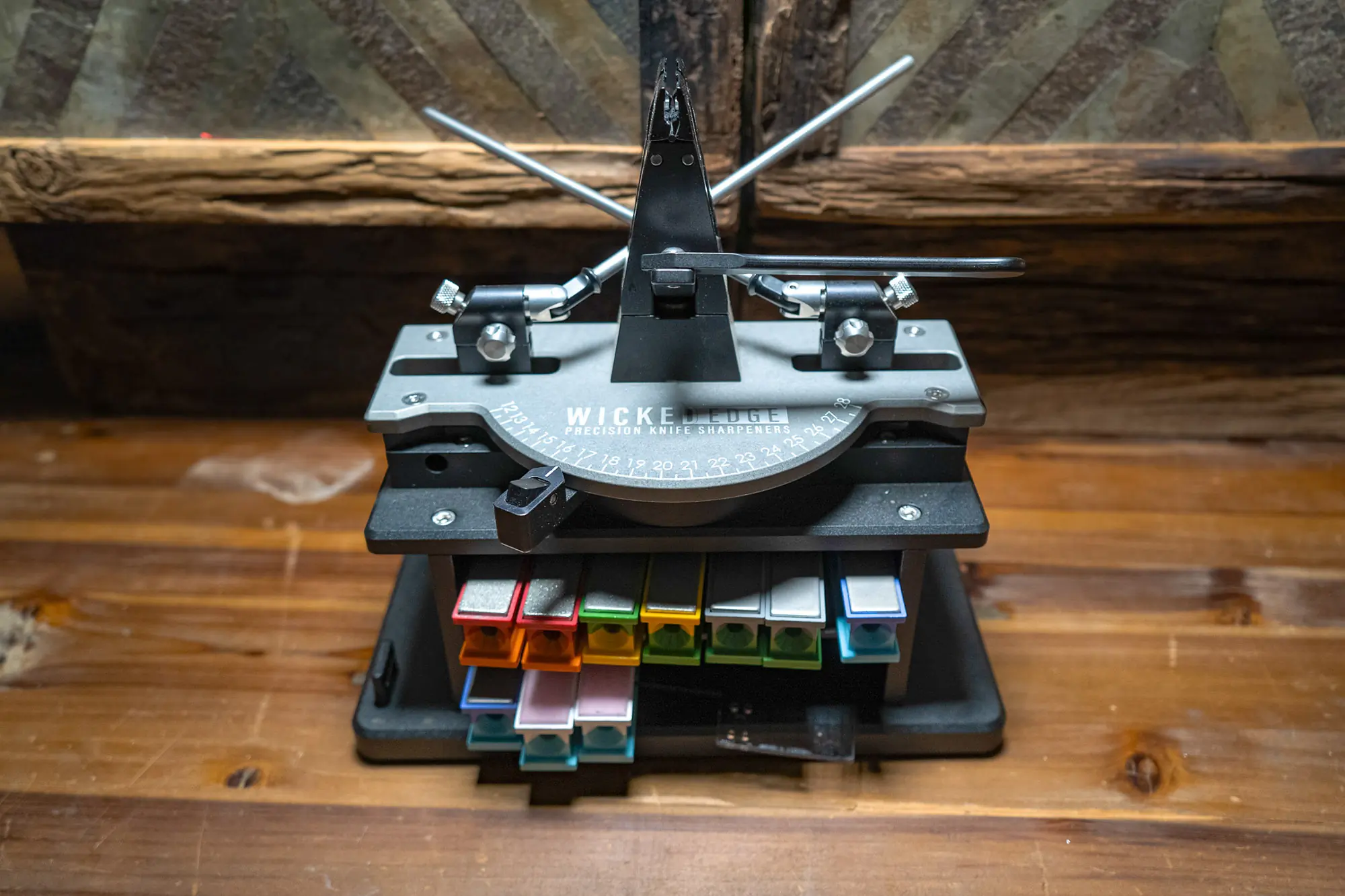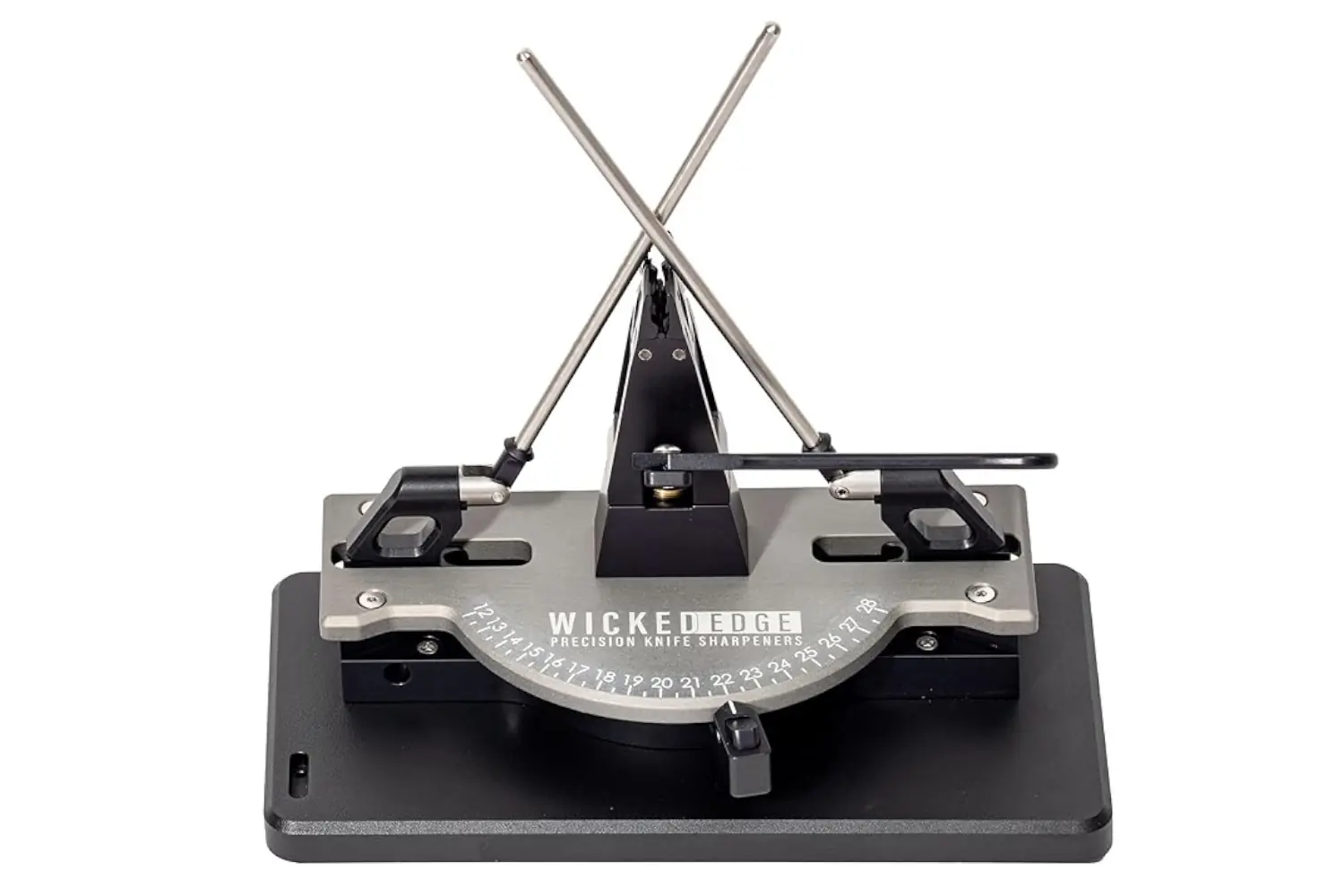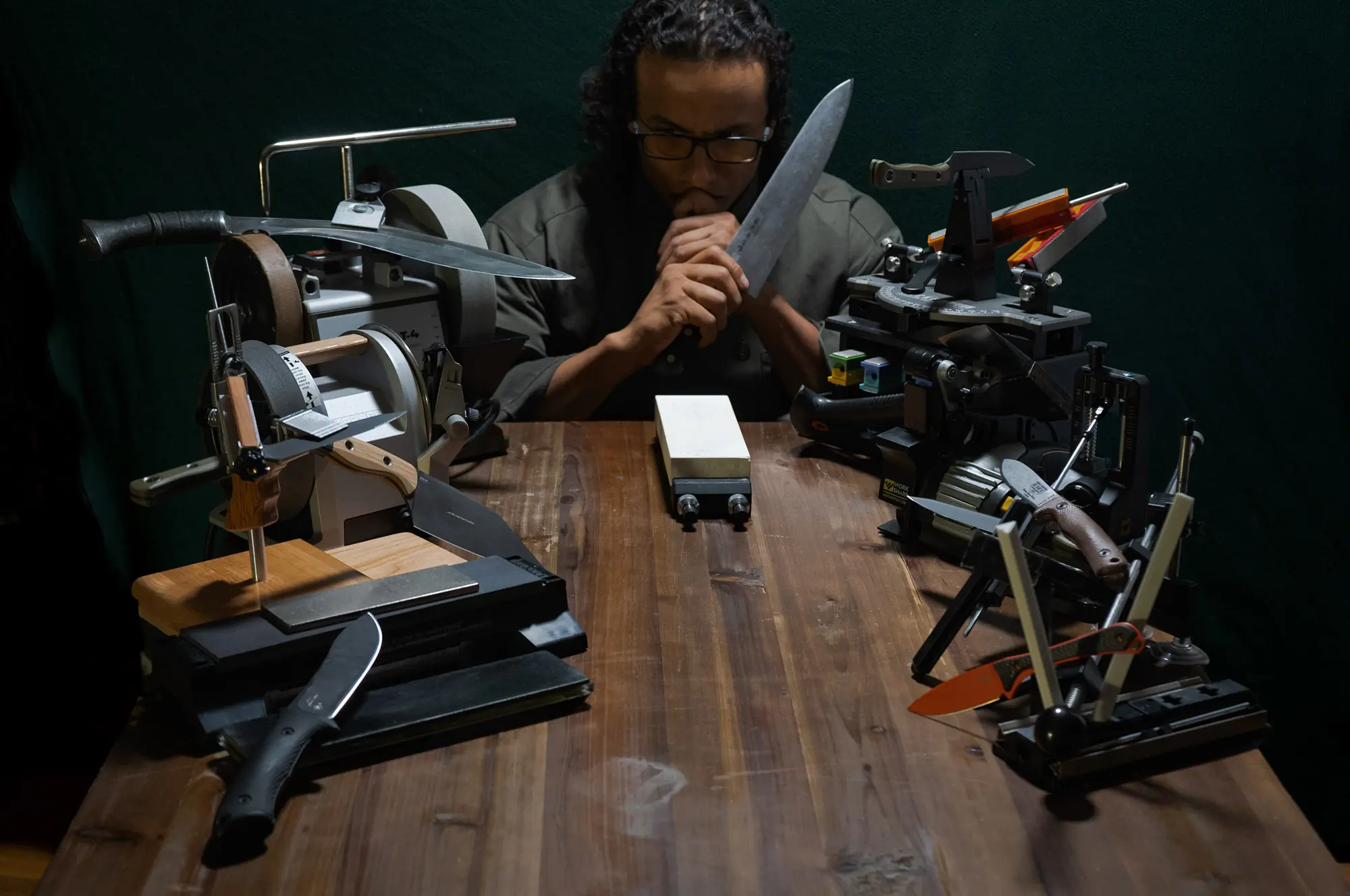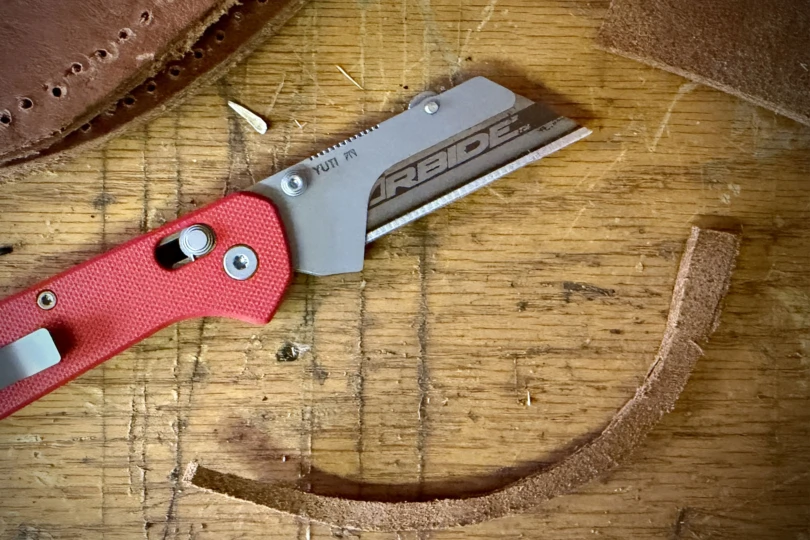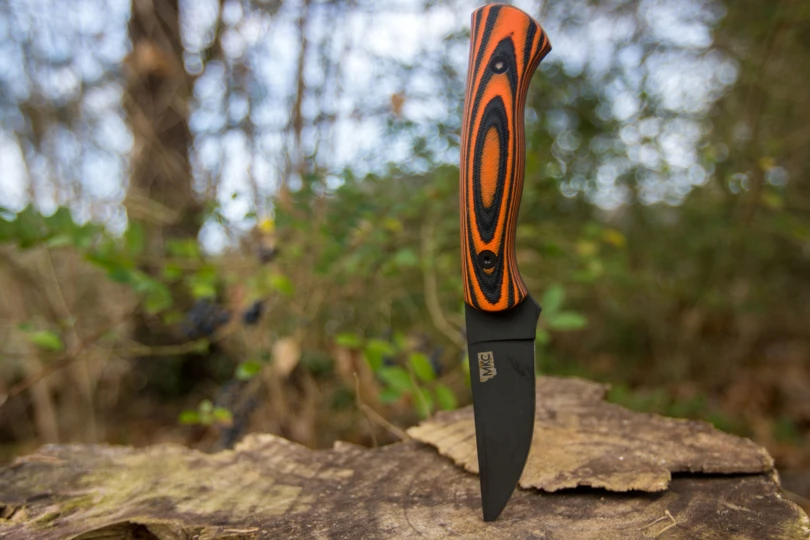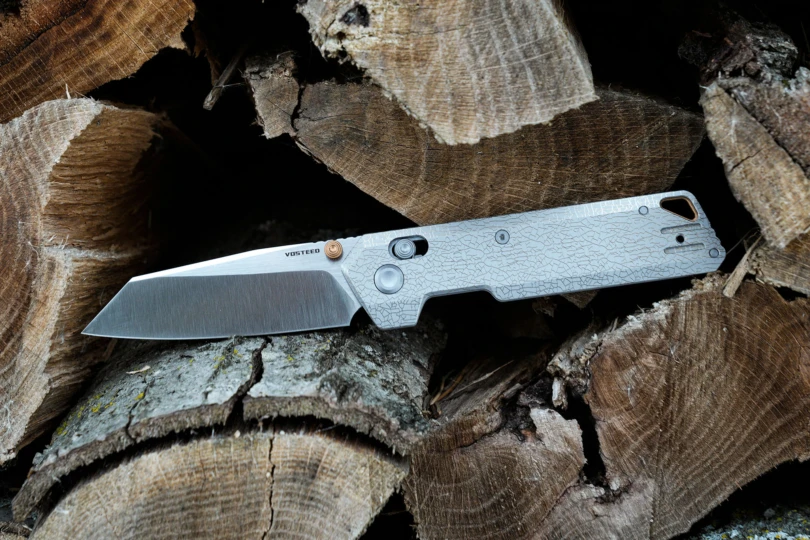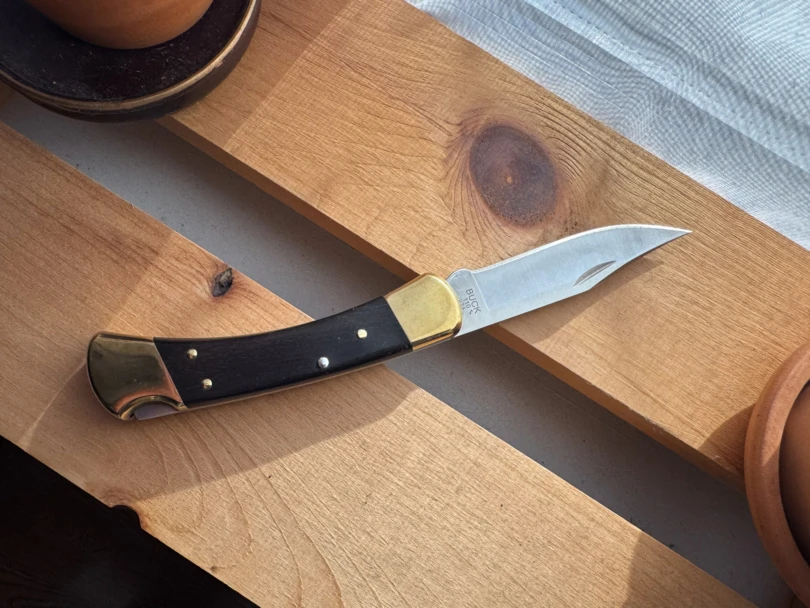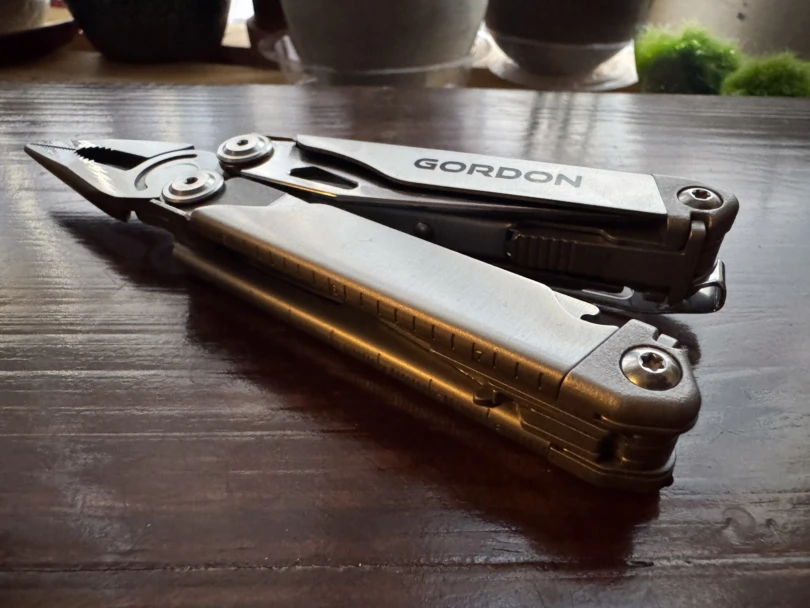A universal oddity of any hobby: justifying the gear prices to those on the outside. Mountain bikers get to explain why their dream downhill bike costs more than a motorcycle. Ultralighters get to explain to casual hikers why a pack that taps out at 15 pounds costs several hundred dollars. For knife aficionados, there’s justifying a sharpener that starts at a grand.
The Wicked Edge Generation 4 Pro isn’t the fastest option for heavy sharpening, and it’s not ideal for tools like axes. Getting the most out of it requires plenty of extra accessories. Yet, the Gen 4 is one of my top picks, even among our roundup of the best knife sharpeners on the market.
Of the many angle-guided sharpening systems, it’s by far the easiest to use. It’s faster than the vast majority of manual sharpeners. And most of all, it’s just damn well built. A starting price of $1,000 is a high bar to clear to be deemed worth it, but the Gen 4 Pro rightfully sails over it.
In short: The Wicked Edge Generation 4 Pro is the holy grail of knife aficionados for good reason. It’s not the most versatile sharpening system on the market, but nevertheless, its combination of build quality, efficiency, ease of use, and precision makes it easier to get professional-grade edges with the Gen 4 than just about any other sharpening system.
To compare the Wicked Edge Generation 4 Pro to the other knife sharpeners out there, check out GearJunkie’s Best Knife Sharpeners Buyer’s Guide.
- Sharpener Type: Manual, double-sided, clamped, angle-guided
- Angle Range: 12-28 degrees per side; 12-33 with Micro-Adjust
- Grits: 100/200, 400/600, 800/1000
- Size: 7 x 11 x 11.5”
- Best For: Professional-level knife sharpening
- Skill Level: 2 out of 5
Pros
- Ease of use
- Consistency
- Range of accessories
- Integrated storage options
- Build quality
Cons
- Stock vice only accommodates blades under 5 mm thick
- Expensive
- Accessories required for acute and mirror-polished edges
Wicked Edge Generation 4 Pro: Review
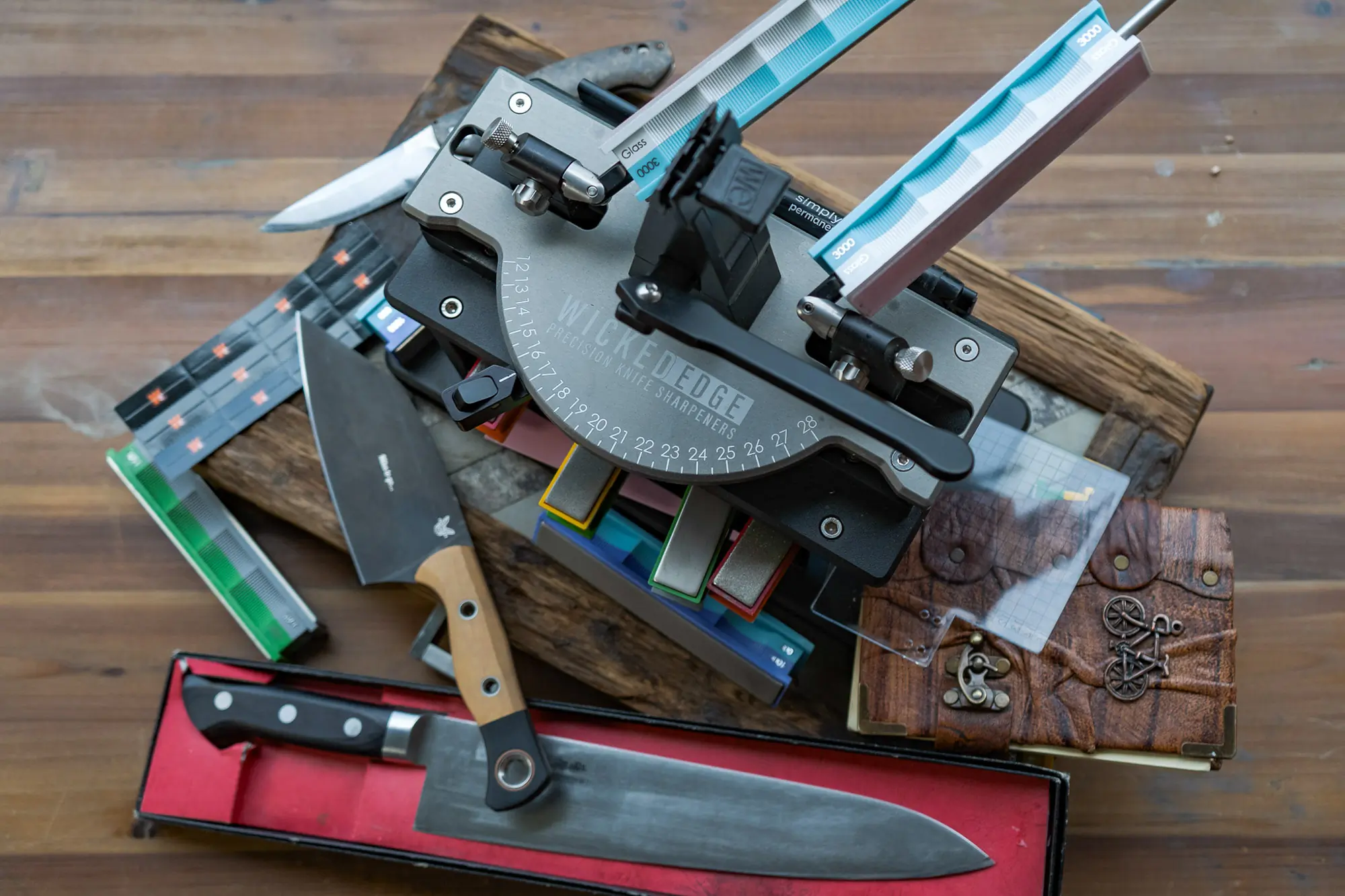
Wicked Edge sharpeners’ central theme is that two hands are better than one. There are many manual angle-guided sharpening systems, and most hold the blade horizontally in the jaws of a clamp. They typically have a guide arm that can hold a stone of some sort. The pivot point of the guide arm can be raised or lowered to adjust the sharpening angle.
The downside to this approach: Hitting either side of a blade, especially long ones that need to be repositioned in the clamp, can be a bit clumsy.
The clamps usually pivot to make this easier. Nevertheless, blades, especially long ones, often have to hang off the edge of a table or countertop to have room to pivot. Even with practiced hands, I’ve nicked myself a time or two on a blade hanging in space, pointed toward me.
Wicked Edge sharpeners instead clamp blades vertically. Guide arms on either side mean you can put both hands to work, alternatively sharpening either side of a blade in a smooth, continuous motion — no pivot necessary. The Gen 4 Pro elevates that approach with next-level engineering.
A heavy base anchors it to any surface. A sliding dial makes minute adjustments to the sharpening angle incredibly easy. The solid, robust clamp can be engaged and disengaged by a handle that folds to the side and stowed out of the way. This makes it a breeze to sharpen long blades that must be sharpened section by section.
A Cut Above the Competition
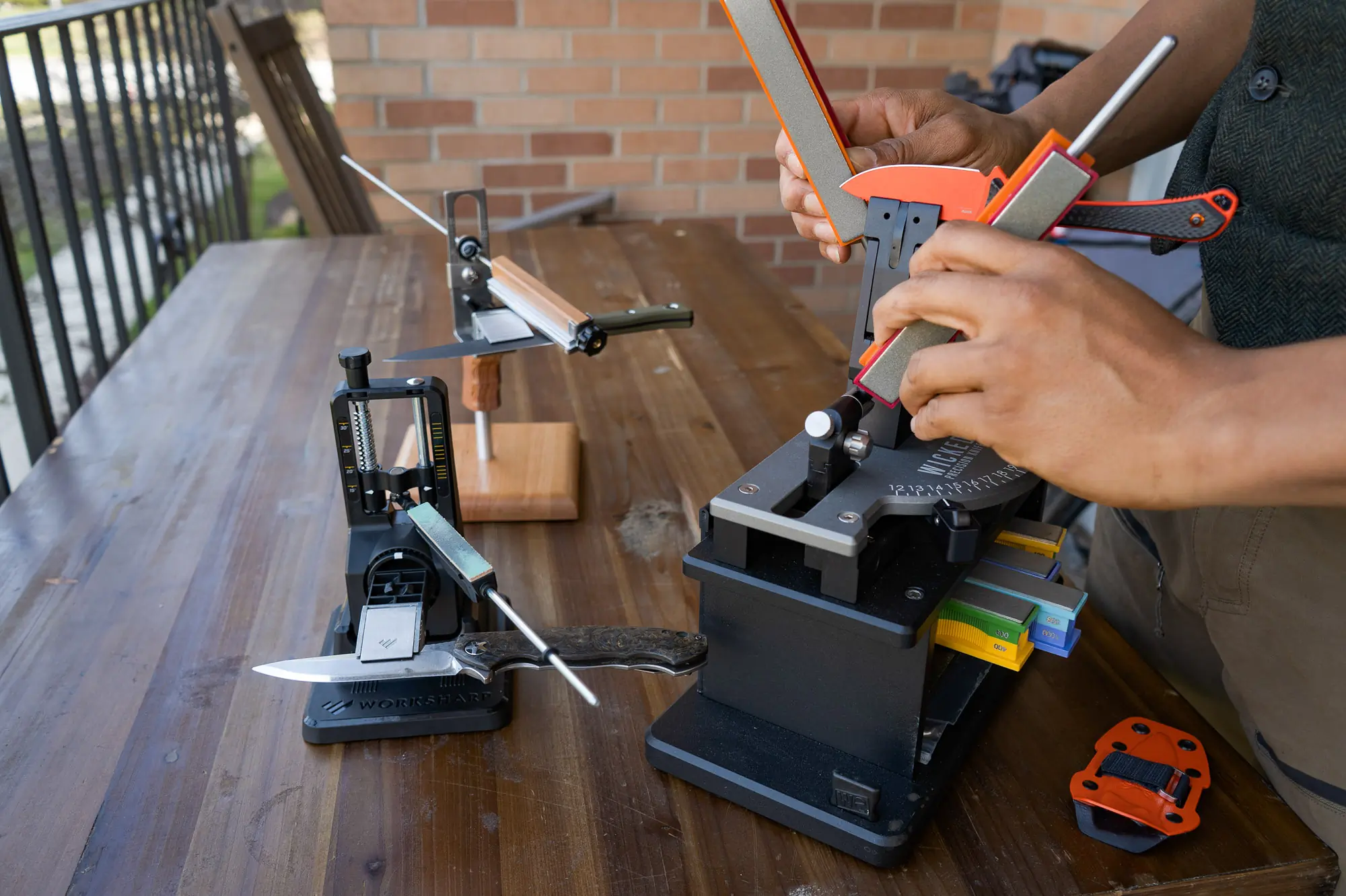



The easiest way to understand what the Gen 4 brings to the table is to stack it up against the competition. Compared to two of GearJunkie’s other favorite clamp base sharpeners, the KME Deluxe and Work Sharp Precision Adjust Elite, the Gen 4’s clamp opens and closes the most easily — allowing blades to be much more quickly secured and adjusted. Fully flat-ground blades, like chef’s knives, more easily and consistently sit perfectly perpendicular.
Wicked Edge’s dual guide-arm design does require two stones of any grit compared to the one of most manual sharpeners. However, the double-sided design allows for smaller, double-sided stones. The angle adjustment system is easier and more fine-tunable.
Without being clamped or mounted to a surface, the KME and Precision Adjust Pro often need a hand to steady them. The base of Gen 4, meanwhile, holds even the largest blades steadily, without the edge close to you.
Edge Pro’s Pro and Apex systems, OGs among manual angle-guided sharpeners, require holding and drawing blades along a table as you sharpen. Comparatively, the Gen 4’s set-it-and-forget-it clamp and more granular angle adjustments are far easier.
The Gen 4 is also much simpler than most electric options. Whetstone grinders like the Tormek T-4 can cost around the same when all is said and done. They’re faster, but they’re more technical, requiring setup, space, know-how, and accessories to get up and running.
Angle-guided belt sanding systems like the Work Sharp Ken Onion and Elite Knife Sharpening Solution are speedy but loud, kick out steel dust, favor convexed edges, and can overheat a blade. The Gen 4 offers more precision, with less room for mistakes.
Clamp Conundrums
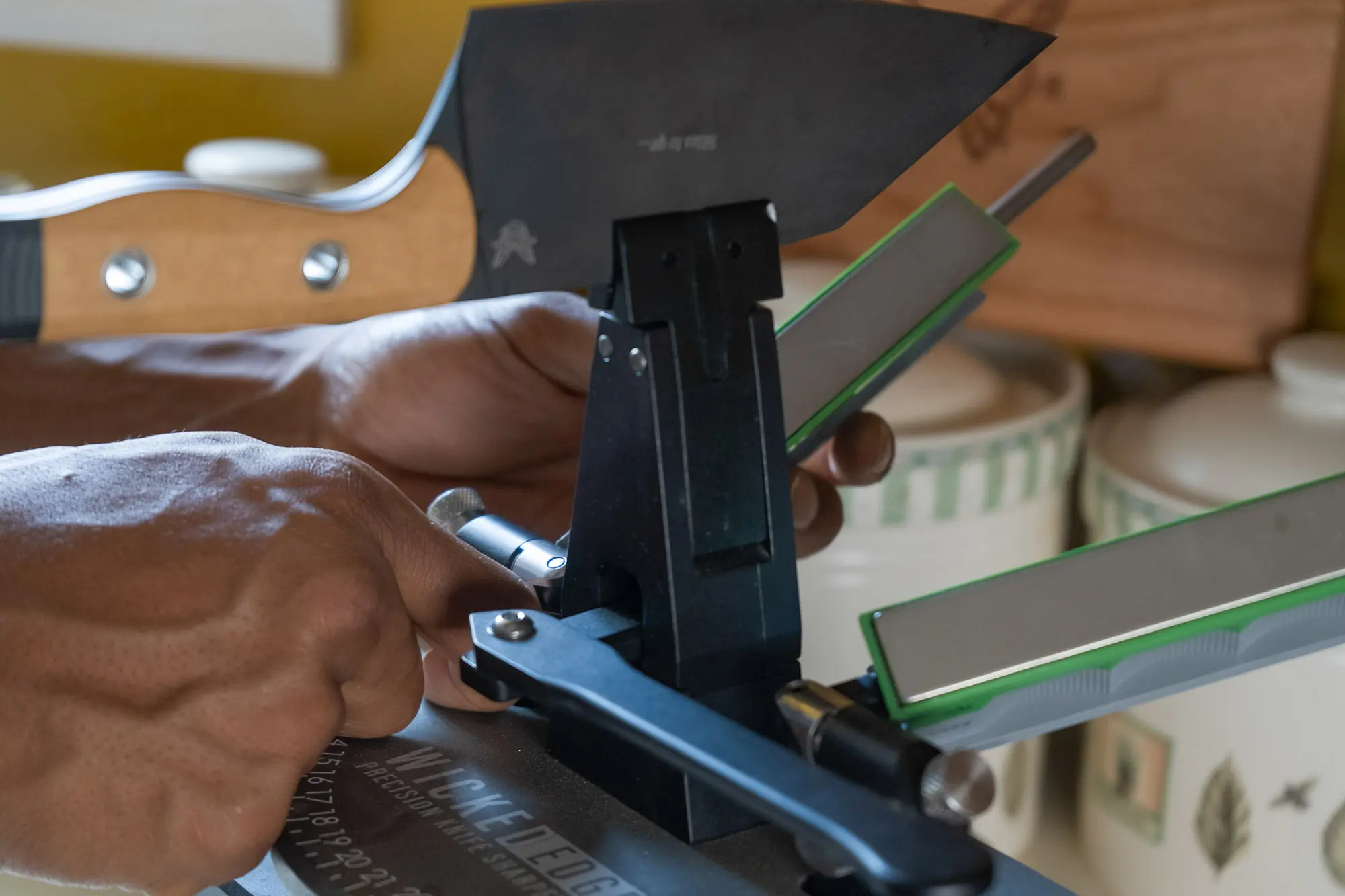



As well-engineered as the Gen 4 is, it shares the pros and cons of any clamp-based sharpener. These types of systems are limited by the width of the blades they can accept. In the Gen 4’s case, that’s 3/16 inches. Wicked Edge offers alternative jaws for thicker blades, but those too tap out at ¼ inch. The vast majority of blades make that cut, but thick, heavy choppers like khukuris might not fit.
The actual sharpening angle of clamp-based systems also rarely matches those listed. It depends on how far a blade protrudes from the clamp. With heavily curved blades, this also means that the sharpening angle will change slightly from base to tip.
For many, having a 30-degree edge at the base of a blade and a 34-degree edge at the tip is a nonissue. A sharpened edge is a sharp edge. However, anyone dropping over a grand on a sharpener, especially if they’re sharpening for clients, is probably a stickler for precision.
The Gen 4 is better than most in that regard. The guide arms’ pivots are relatively far from the clamp. So, there’s less variation in angle along the length and curve of a blade.
Likewise, the Gen 4 has, by far, the easiest and most robust clamp. However, its bulk makes sharpening blades with shallow angles, like Japanese chef’s knives, difficult. For that, you’ll still need a low-angle adaptor, an angle finder, and potentially even longer guide rods.
Cost Considerations
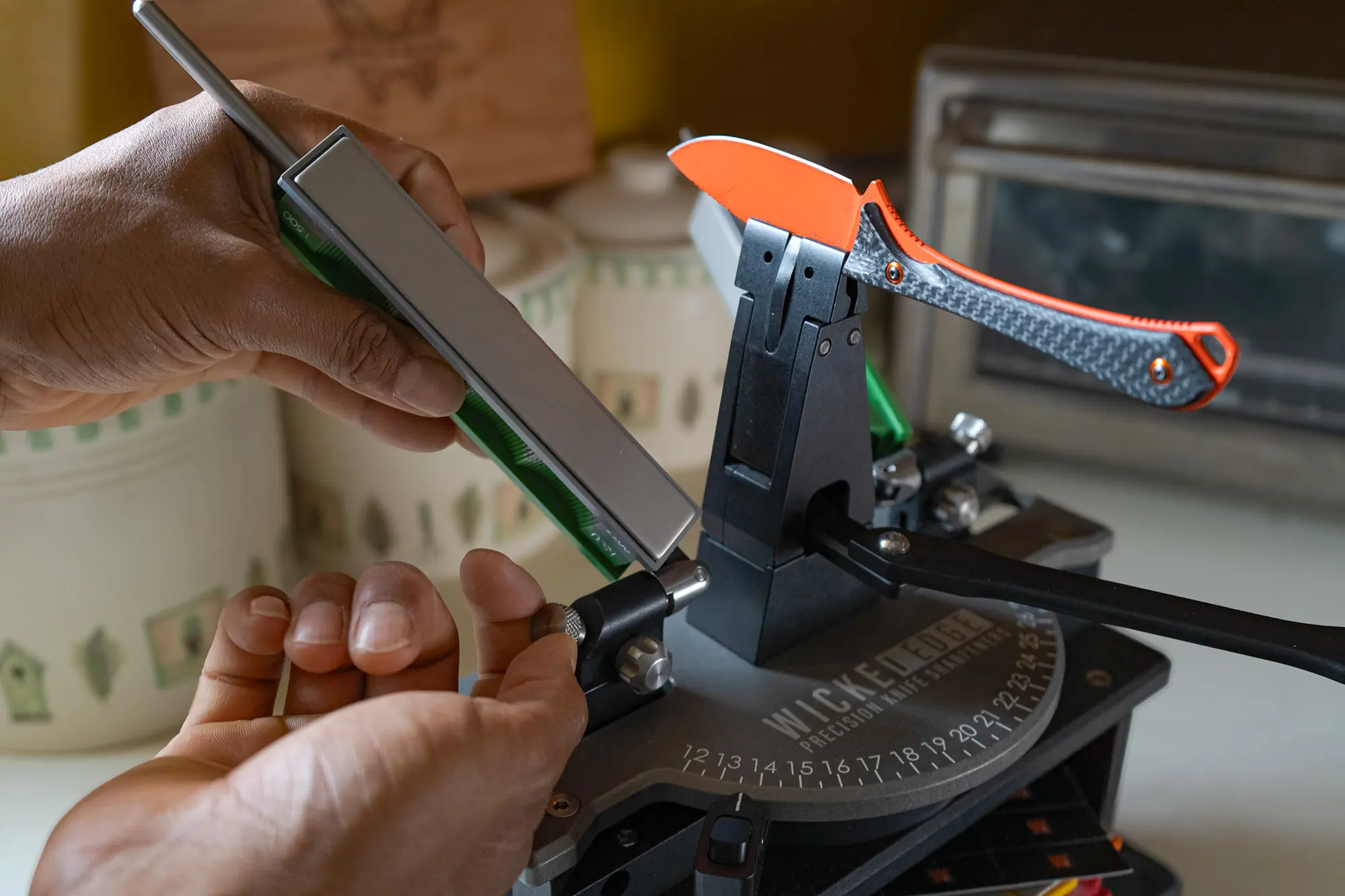



The Generation Pro 4 falls squarely into the “I need to justify this” price bracket. For that, two questions reign supreme: “What’s the value to me?” and, “How does it stack up to other options?”
That first question depends on how heavily you weigh satisfaction. Ask any pocket knife collector — there’s just something satisfying about good engineering. Next to my aquarium and quiches, the Gen 4 is the most beautiful thing on my countertop. It’s exceptionally well built and by far the best compromise between quality and ease of use of any sharpener I’ve ever used.
As someone who sharpens professionally for collectors, commercial kitchens, and landscapers alike, it’s a mixed bag. For most knives, it’s fantastic. Resharpening even the hardest steels is easy. Cutlery takes no time. And over the last few months, I’ve used it more for my own blades than any other system I own.
However, that has as much to do with the accessories as the base system. I opted for built-in storage to neatly house all of the stones and accessories. That’s an extra $300. Mine has a micro-adjust, to expand the range of angles it can hit, and make matching existing angles easier. But that was another $200. I also have extra stones that can take an edge from reasonably damaged to mirror-polished, but that was another $250.
I occasionally sharpen for a sushi restaurant. The Gen 4 is fantastic for this — with a Low Angle Kit that runs another $141.
However, for knocking on the door of nearly 2 grand, it suffers in versatility. Restoring heavily damaged edges on axes and tools? It’s far from ideal. Completely regrinding the edges of super hard steels? It’s slow. Thick, unusual tools like chisels and wood-turning equipment are all but off the table. So, at that price, how does it stack up?
Other Sharpeners to Consider
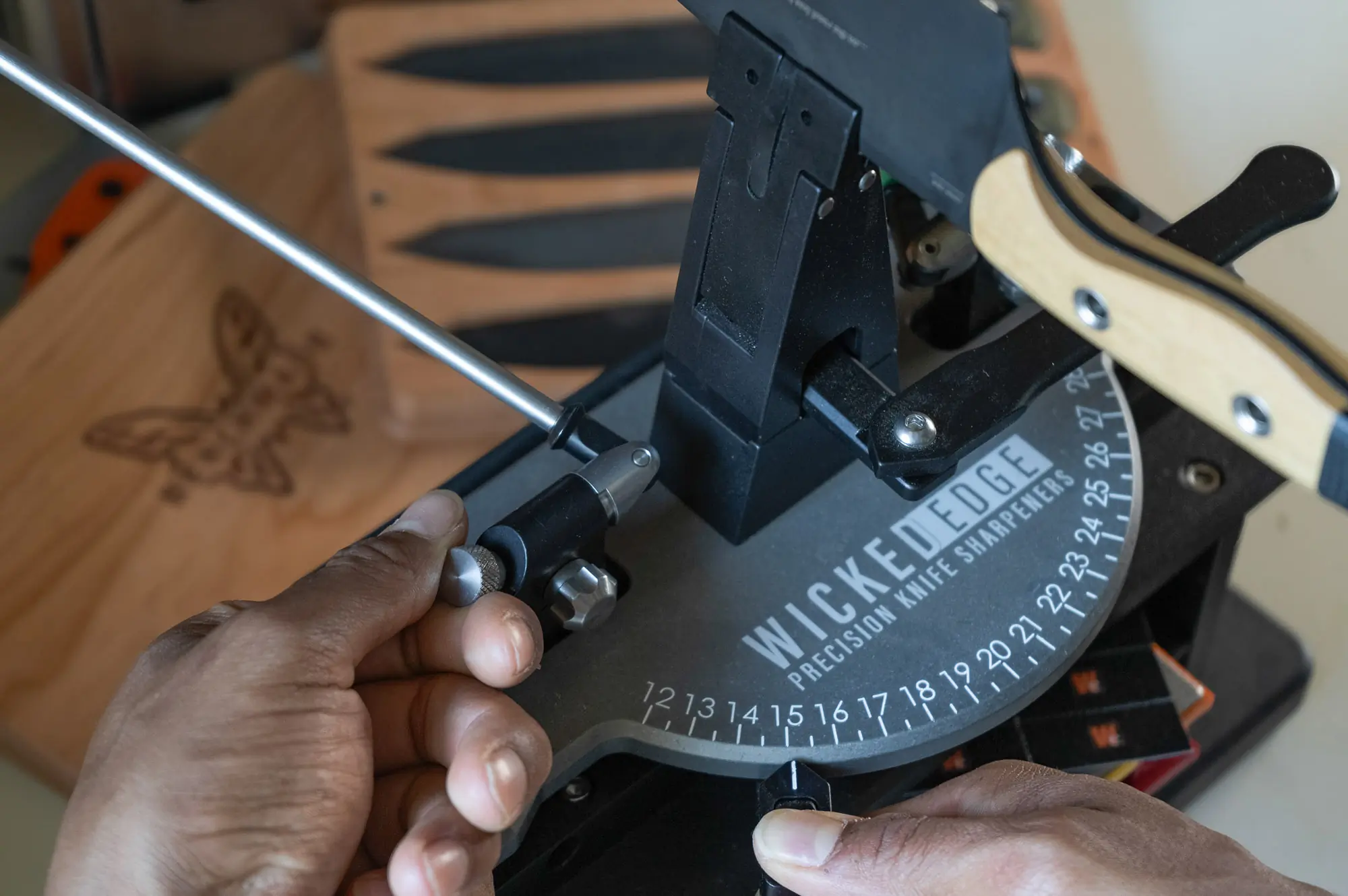



What does the Gen 4 do that others don’t? Well, it’s more streamlined than other clamp-based systems. Work Sharp’s Precision Adjust Pro is more unwieldy, slower, and has a more finicky clamp, but it also offers angle micro-adjustments with an angle finder.
The KME offers much less granularity for angle adjustments, requires a hand to steady the base, and can be more awkward. However, it’s more portable and comes with a wide grit range of diamond stones that makes it just as fast as the Gen 4 at taking an edge from dull or damaged to polished.
Edge Pro easily has the most involved manual systems. All of them forgo a clamp, requiring one hand to hold and draw a blade along a table. The base of their Apex model, in particular, is far less secure. Its stock whetstones are arguably the slowest in the lineup, require soaking before use, and need to be leveled regularly.
However, Edge Pro’s design means that as long as the edge of a blade is just over the edge of the table, the sharpening angle is exactly what it says it is. They also offer a glut of accessories, including diamond stones, that make it easy to get a quality system up front, and upgrade it over time for much less.
Compared to electric systems, the Gen 4 is a slow, detail-oriented specialist. Work Sharp’s Elite Knife Sharpening Solution is loud, messy, and less precise — but a cost-effective beast for heavy regrinding jobs, long or awkward blades, and heavy-duty tools like axes.
The Tormkek T-4 is easily one of the most complex powered sharpeners around. Getting the most out of it requires extra wheels and jigs, putting it close to the Gen 4’s price range. Ultimately, though, from wood-turning equipment to santokus, there are precious few tools that the T-4 can’t sharpen.
Wicked Edge Generation 4 Pro: Cut to the Chase
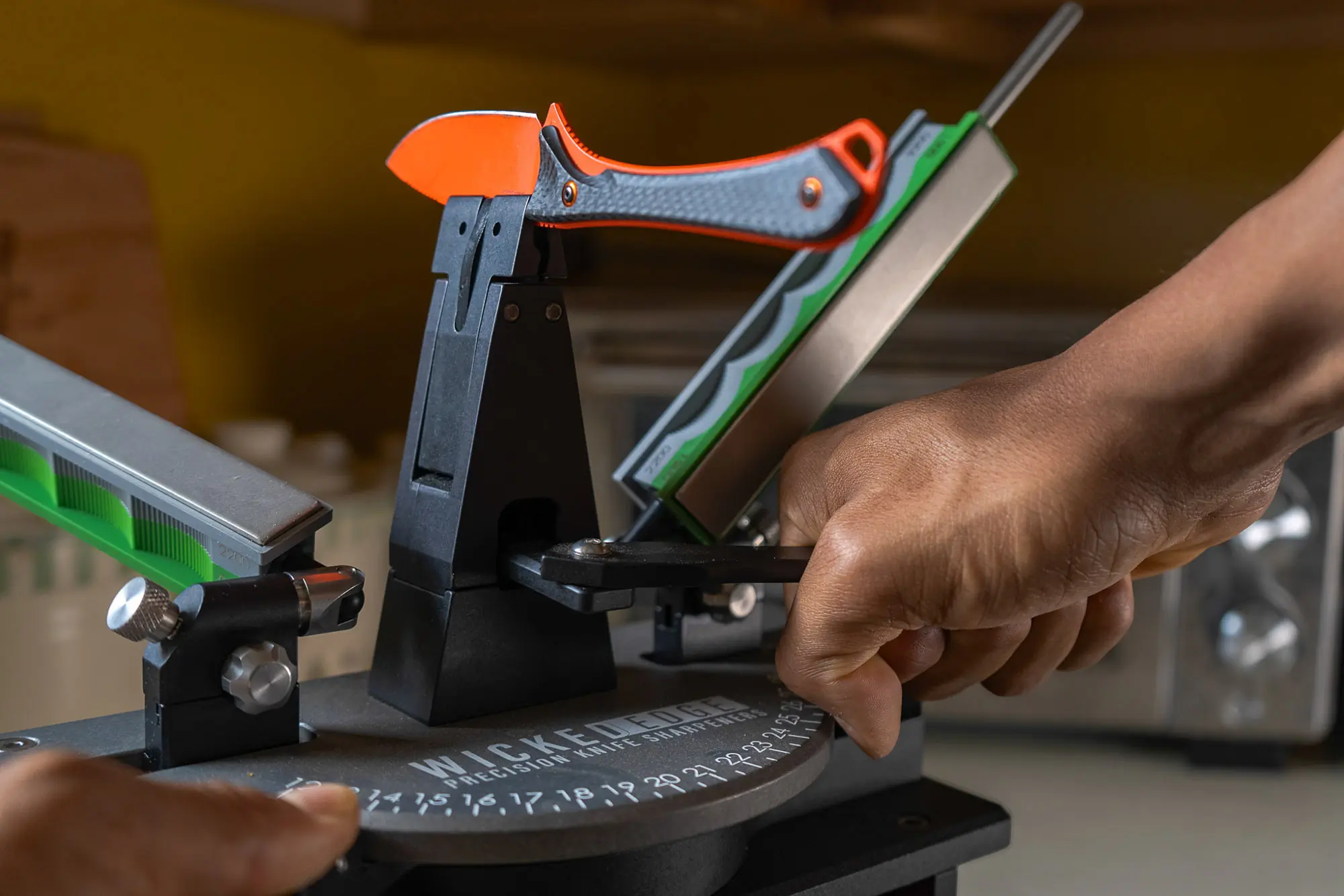



The name of the Wicked Edge Generation 4 Pro’s game is an up-front premium for perfect balance. There’s no shortage of manual, angle-guided sharpeners on the market, and the Gen 4 is solidly atop the masses. It’s quicker and more precise than most of them, and it’s easier to use (and arguably safer) than all of them.
There’s little leeway to get a basic version up front and kit it out later. That would mean getting a different Wicked Edge platform entirely. But convenient features like the storage shelf and micro adjust can be sacrificed for the most utilitarian extras like more stones and the low-angle adapter.
When I need to completely regrind hard steel or heavily sharpen tools — lawnmower blades, machetes, hatchets, chisels, and the like — I still reach for my T-4 or Work Sharp Elite. I’ll have the job done in a third of the time.
But from my favorite gyuto chef’s knife and standby EDC to the blades of clients who are picky about their edges — the sushi chefs down the street, antique collector friends, the regulars I bartend for who want mirror polish on their latest piece — the Gen 4 is my first choice.
It’s big. It’s expensive. If I didn’t literally put my nose to grindstones as a side gig — it’d be hard to justify. But with half an excuse, boy, if it isn’t satisfying, and damned if it doesn’t make getting a wicked edge as simple as it ever could be. There are myriad manual angle-guided sharpeners on the market, but the Wicked Edge Generation 4 Pro is the best I’ve used so far.
